|
Cruising the
Marquesas
May
7, 2002
Now
that you have sweated with us through our Big Passage, we thought we
should tell you about life "on the other side." For the past few weeks
we've been cruising among five islands of the Marquesas group. We stayed
first in Atuona on the island of Hiva Oa, to check in with the gendarmes,
to provision and to drop our crew off at the airport. Mark and Mike have
both left now, so we are back to cruising à deux.
Metropolitan Atuona
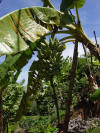 Atuona harbor is not the most comfortable place we've ever been. It's a
bit crowded - usually 15 to 25 boats - very rolly and hot. The water is
murky, so the swimming isn't very nice. The rumor was that there were
sharks, but our Marquesan tour guide, Pepe, squashed that idea flat. The
benefits are that the army base, which looks like a posh harbor-side
resort, has a troop of soldiers who sing on their way to the mess hall.
Quite charming. Then there are roosters crowing in the mornings, always a
nice third world touch. There is even a little store at the gas station on
the dock that sells the necessities of life like fresh baguettes every
morning at 7:30. No one seems to sell ice, but it would be a wet puddle by
the time it got back to the boat anyway. We are trying to build up our ice
supply by filling small plastic containers and freezing them. So give your
icemaker a hug today! When you really need one in 90 degree heat and 70%
humidity, they are not to be found. Atuona harbor is not the most comfortable place we've ever been. It's a
bit crowded - usually 15 to 25 boats - very rolly and hot. The water is
murky, so the swimming isn't very nice. The rumor was that there were
sharks, but our Marquesan tour guide, Pepe, squashed that idea flat. The
benefits are that the army base, which looks like a posh harbor-side
resort, has a troop of soldiers who sing on their way to the mess hall.
Quite charming. Then there are roosters crowing in the mornings, always a
nice third world touch. There is even a little store at the gas station on
the dock that sells the necessities of life like fresh baguettes every
morning at 7:30. No one seems to sell ice, but it would be a wet puddle by
the time it got back to the boat anyway. We are trying to build up our ice
supply by filling small plastic containers and freezing them. So give your
icemaker a hug today! When you really need one in 90 degree heat and 70%
humidity, they are not to be found.
The town of Atuona is a mile or so from the harbor, up a very hot hill of
course. Luckily, every time we have gone in, some kind local has picked us
up. We have spent most of our shore time traveling in the back of pickup
trucks, another bit of third world charm. We're just thrilled to have a
ride, no matter how risky.
 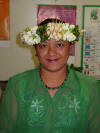 Atuona is pretty much a one horse, one street town with the gendarmerie, a
post office, four stores or magazins, two snack bars, a mini-bank, the
tiny Air Tahiti office, a museum, a craft shop, and that is IT. At first,
the 4 magazins seemed pretty empty of anything remotely useful, but that
was on our first foray. After we were more rested and not so picky, we
were able to find most of the things we needed, except fresh vegetables.
It was very nice to be able to speak French to ask where to find things.
Take honey for example. It wasn't in anything recognizable like a jar, but
we finally asked and there it was in recycled wine bottles without labels.
The stores are very dark too, which makes it all a bit mysterious. Each
one sells a mixture of food, alcohol, clothing, hardware, toys, etc. Ever
hanker for some nice canned mackerel? It's a big item here, for reasons we
can't fathom. Everything is expensive, but it is all brought in by ship
once a month, so one pays what one must. For example, the local beer,
Hinano, is twelve dollars a six-pack. No, that's not a misprint:
$12/six-pack. After the Mexican beer ran out, Mike and Mark became quite
partial to Hinano, so we had to keep a good supply chilled. The baguettes,
highly subsidized by the French government, cost thirty cents apiece, a
real deal and the only cheap thing here. Atuona is pretty much a one horse, one street town with the gendarmerie, a
post office, four stores or magazins, two snack bars, a mini-bank, the
tiny Air Tahiti office, a museum, a craft shop, and that is IT. At first,
the 4 magazins seemed pretty empty of anything remotely useful, but that
was on our first foray. After we were more rested and not so picky, we
were able to find most of the things we needed, except fresh vegetables.
It was very nice to be able to speak French to ask where to find things.
Take honey for example. It wasn't in anything recognizable like a jar, but
we finally asked and there it was in recycled wine bottles without labels.
The stores are very dark too, which makes it all a bit mysterious. Each
one sells a mixture of food, alcohol, clothing, hardware, toys, etc. Ever
hanker for some nice canned mackerel? It's a big item here, for reasons we
can't fathom. Everything is expensive, but it is all brought in by ship
once a month, so one pays what one must. For example, the local beer,
Hinano, is twelve dollars a six-pack. No, that's not a misprint:
$12/six-pack. After the Mexican beer ran out, Mike and Mark became quite
partial to Hinano, so we had to keep a good supply chilled. The baguettes,
highly subsidized by the French government, cost thirty cents apiece, a
real deal and the only cheap thing here.
Hiva Oa Island Tour
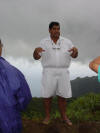 One day just after we arrived, the four of us - Jan, Signe, Mike, and Mark
- took a 4x4 tour of the island with Pepe, the Seventh Day Adventist
pastor who doubles as a tour guide. There is one road around the island,
mostly steep, twisty, muddy, terminally rutted, and with plenty of rock
falls, washouts and construction-in-progress, which we immediately dubbed
the Hiva Oa Freeway. Parts of it near three towns are paved, but the rest
is amazing. And you can just forget guardrails! We were very glad we
weren't driving. The islands are all volcanic and mountainous, so some of
the switchbacks were overly thrilling for the seaside passengers. The
scenery is spectacular, however, and the vegetation exotic. There are wild
pigs and goats everywhere. They are the main supply of fresh meat,
although the freezers in the stores are full of New Zealand lamb. Curried
goat is very big in the two snack bars, although we haven't yet indulged. One day just after we arrived, the four of us - Jan, Signe, Mike, and Mark
- took a 4x4 tour of the island with Pepe, the Seventh Day Adventist
pastor who doubles as a tour guide. There is one road around the island,
mostly steep, twisty, muddy, terminally rutted, and with plenty of rock
falls, washouts and construction-in-progress, which we immediately dubbed
the Hiva Oa Freeway. Parts of it near three towns are paved, but the rest
is amazing. And you can just forget guardrails! We were very glad we
weren't driving. The islands are all volcanic and mountainous, so some of
the switchbacks were overly thrilling for the seaside passengers. The
scenery is spectacular, however, and the vegetation exotic. There are wild
pigs and goats everywhere. They are the main supply of fresh meat,
although the freezers in the stores are full of New Zealand lamb. Curried
goat is very big in the two snack bars, although we haven't yet indulged.
 At one point we stopped at a fruit farm owned by a man who introduced
himself to each of us as "Okono" in a thick Marquesan accent. He's an
extremely pale, white man with grey hair, but did not speak anything but
Marquesan and a little French, which threw us for a loop. We finally
figured out his name was "O'Connor." He was born here of an Irish father
and a Marquesan mother, and has 24 children of his own. He was very happy
to sell us stalks of bananas, papayas, pamplemousse (grapefruit on
steroids; delicious), avocados, and cucumbers. At one point we stopped at a fruit farm owned by a man who introduced
himself to each of us as "Okono" in a thick Marquesan accent. He's an
extremely pale, white man with grey hair, but did not speak anything but
Marquesan and a little French, which threw us for a loop. We finally
figured out his name was "O'Connor." He was born here of an Irish father
and a Marquesan mother, and has 24 children of his own. He was very happy
to sell us stalks of bananas, papayas, pamplemousse (grapefruit on
steroids; delicious), avocados, and cucumbers.
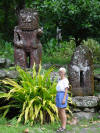 A highlight of the tour was an ancient archeological site, a series of
stone ceremonial platforms used by the local chiefs until the late 1880s.
The Marquesas had a population of 80-100,000 people when Europeans first
arrived, so the valleys on all the islands teemed with people. Their
society was highly stratified and warlike, and cannibalism and human
sacrifice were very real. The site at Puama'u was mysterious and moving,
nearly overgrown with tropical vegetation, and with several stone tikis
for atmosphere. We'll write again and tell you more about the Polynesian
people and their fascinating civilization. A highlight of the tour was an ancient archeological site, a series of
stone ceremonial platforms used by the local chiefs until the late 1880s.
The Marquesas had a population of 80-100,000 people when Europeans first
arrived, so the valleys on all the islands teemed with people. Their
society was highly stratified and warlike, and cannibalism and human
sacrifice were very real. The site at Puama'u was mysterious and moving,
nearly overgrown with tropical vegetation, and with several stone tikis
for atmosphere. We'll write again and tell you more about the Polynesian
people and their fascinating civilization.
There are almost zero land-based tourists here, although there is one
small hotel and a couple of pensions. The only visitors are us cruisers,
so tourist essentials like restaurants and internet cafes are in short
supply. There are also no marine supply stores, so people are struggling
to find parts to repair things that broke on the passage over. One boat
broke its boom and they have a real project going to rig a temporary one.
Thank goodness for Jan and his twelve big spare parts bins!
One major issue that we are now facing is a lack of laundromats or nice
ladies to do a fluff-and-fold like in Mexico. As Jan said, "We spent lots
of time doing maintenance on the boat, but forgot to maintain the washing
machine," which has now packed it in. So I did three weeks worth of
laundry for four by hand in the galley sink, and hung it on the lifelines
to dry. This is what everybody else is doing, too, so it's quite colorful
around here. One friend said he had just bought his wife a new washer - a
plumber's plunger that she uses to agitate the laundry in a bucket. There
is also a big rock and a faucet on shore, but I haven't sunk that low yet!
The Marquesans are very large people, the men being descendants of
warriors, as Pepe would say. The women are often quite plump, but usually have
arrangements of flowers in their hair, making the whole effect quite
lovely. There are flowers everywhere, in the bank, in the Air Tahiti
office. It's great and smells fabulous. The whole island has a very
different smell from Mexico, very lush, verdant and clean.
Tahuata
 Another favorite anchorage has been Hanamoenoa on an island called Tahuata
(there'll be a quiz later). It is the opposite of Atuona, an idyllic
paradise with crystal clear turquoise water, no swell, a white sand beach
(unusual in the volcanic Marquesas) with palm trees, but no civilization.
We loved swimming off the boat, did some repair projects in the calmer
water, and hung out with friends. It was a great place to recover from the
passage. Another favorite anchorage has been Hanamoenoa on an island called Tahuata
(there'll be a quiz later). It is the opposite of Atuona, an idyllic
paradise with crystal clear turquoise water, no swell, a white sand beach
(unusual in the volcanic Marquesas) with palm trees, but no civilization.
We loved swimming off the boat, did some repair projects in the calmer
water, and hung out with friends. It was a great place to recover from the
passage.
We are meeting many more international boats now, many on
circumnavigations. There are Dutch, French, British, Italian, and
Australian boats galore. The Americans and Canadians are now in the
minority. It makes for interesting gatherings.
Today we were going to leave for another island, Fatu Hiva, but it has
been raining horizontally all night, so we thought better of it. We're
making cookies and collecting rainwater in our water tanks instead. We're
also sitting in the pilothouse watching the rain and reading, very much
like we used to do on the screened in porch in Stone Harbor, New Jersey.
It's kind of cozy.
Fatu Hiva
 We finally struck out for Fatu Hiva, an upwind sail. It took us about six
hours and was pretty wet and unpleasant, but worth the voyage. Hanavave
Bay is at the base of some rather spectacular and peculiar volcanic
spires. The story goes that the Marquesan name for the place was Penis
Bay, or Baie des Verges in French. (Check the photo to see what they
meant.) When the missionaries arrived, they really didn't approve of the
name, so they added an "i" and changed it to Baie des Vierges, or Virgins Bay. Anyway, it
is the most dramatic place we have ever anchored. There is lush vegetation
all around, waves crashing on the shore, gusty winds blowing through a gap
in les verges, etc. Our Canadian friends aboard By Chance had just arrived
after a 23 day passage and were eager to set foot on land. So we took the
dinghy into a very surgy concrete ramp and scrambled ashore. We finally struck out for Fatu Hiva, an upwind sail. It took us about six
hours and was pretty wet and unpleasant, but worth the voyage. Hanavave
Bay is at the base of some rather spectacular and peculiar volcanic
spires. The story goes that the Marquesan name for the place was Penis
Bay, or Baie des Verges in French. (Check the photo to see what they
meant.) When the missionaries arrived, they really didn't approve of the
name, so they added an "i" and changed it to Baie des Vierges, or Virgins Bay. Anyway, it
is the most dramatic place we have ever anchored. There is lush vegetation
all around, waves crashing on the shore, gusty winds blowing through a gap
in les verges, etc. Our Canadian friends aboard By Chance had just arrived
after a 23 day passage and were eager to set foot on land. So we took the
dinghy into a very surgy concrete ramp and scrambled ashore.
 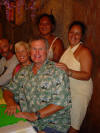 We were immediately adopted by several large women, who took us on a tour
through the town. Then they asked if we would like them to prepare a Marquesan Feast for us. We organized the other boats in the harbor to join
us for the feast the next night. Meanwhile, we visited one of the
best-known local carvers, Temo, and bought a wonderful rosewood manta ray
from him. There are some very talented artisans in these islands. On each
island we visit, the carvings are a little different. We can't resist and
keep buying carved turtles, manta rays and dolphins. Jan fell in love with
a beautifully carved canoe paddle and we have that stashed in one of the
aft cabins. Who knows where it will all end up? We were immediately adopted by several large women, who took us on a tour
through the town. Then they asked if we would like them to prepare a Marquesan Feast for us. We organized the other boats in the harbor to join
us for the feast the next night. Meanwhile, we visited one of the
best-known local carvers, Temo, and bought a wonderful rosewood manta ray
from him. There are some very talented artisans in these islands. On each
island we visit, the carvings are a little different. We can't resist and
keep buying carved turtles, manta rays and dolphins. Jan fell in love with
a beautifully carved canoe paddle and we have that stashed in one of the
aft cabins. Who knows where it will all end up?
The town is hilly and shaded by fruit trees of all varieties. Chickens
with baby chicks, pigs in their pens, horses and even a cow were part of
the scenery. There were heavily perfumed flowers all around us. It was
truly a tropical paradise. The children all wanted to tag along on the
tour with us, so we started feeling like the pied pipers.
 We asked our lady guides if there was anyone who could drive us over the
top of the island to the other town of Omoa. Moana, the technician for the
telecom company and owner of one of the only two motor vehicles in town
(Toyota has a lock on the 4x4 pickup business here), had a day off so he
became our driver for the day (for a fee, of course). Moana turned out to
be a very knowledgeable guy in his thirties and a We asked our lady guides if there was anyone who could drive us over the
top of the island to the other town of Omoa. Moana, the technician for the
telecom company and owner of one of the only two motor vehicles in town
(Toyota has a lock on the 4x4 pickup business here), had a day off so he
became our driver for the day (for a fee, of course). Moana turned out to
be a very knowledgeable guy in his thirties and a
 great driver on the
amazingly bad roads, worse than on Hiva Oa - steep switchbacks, big
boulders and wheel grabbing ruts. The views from the tops of the peaks
were worth every squeamish moment, however. The tops of the mountains are
full of immense mango forests, guava trees, lemon trees, etc. On the way
home great driver on the
amazingly bad roads, worse than on Hiva Oa - steep switchbacks, big
boulders and wheel grabbing ruts. The views from the tops of the peaks
were worth every squeamish moment, however. The tops of the mountains are
full of immense mango forests, guava trees, lemon trees, etc. On the way
home we picked up three huge plastic bags full of mangoes. I kept thinking
that each one of those mangoes was worth at least $3.00 at Queen Ann Thriftway, and I had three bags full! (Ariana of By Chance and I spent the
next day making an immense quantity of mango chutney.) we picked up three huge plastic bags full of mangoes. I kept thinking
that each one of those mangoes was worth at least $3.00 at Queen Ann Thriftway, and I had three bags full! (Ariana of By Chance and I spent the
next day making an immense quantity of mango chutney.)
 Omoa is a larger, more sophisticated town, lacking some of the remote
charm of Hanavave. The day that we were there, the supply ship, the Aranui,
was in town with its 60-odd passengers. The passengers are strictly an
adjunct to the main purpose of the Aranui, which is to pick up and
discharge freight to the islands every month. The benefit to Omoa is a larger, more sophisticated town, lacking some of the remote
charm of Hanavave. The day that we were there, the supply ship, the Aranui,
was in town with its 60-odd passengers. The passengers are strictly an
adjunct to the main purpose of the Aranui, which is to pick up and
discharge freight to the islands every month. The benefit to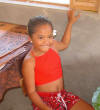 us when the Aranui is in town is that the restaurants and craft us when the Aranui is in town is that the restaurants and craft
 shops all have their
best stuff available for the passengers. As soon as the Aranui departs, it
all gets packed up again. So we did some fast shopping in Omoa - the canoe
paddle, some tapa cloth and a pareo for me. shops all have their
best stuff available for the passengers. As soon as the Aranui departs, it
all gets packed up again. So we did some fast shopping in Omoa - the canoe
paddle, some tapa cloth and a pareo for me.
On Sunday we went to church, obligatory when you cruise the South Pacific
islands. The three-part singing is not to be missed. It was really
beautiful and yet another moment when we had one of those "What are we
doing here?" thoughts. The ladies were all dressed in their best tropical
flowered dresses with black pearl earrings and necklaces and the
traditional flowered hair ornaments - and flip-flops, the dress shoe of
choice. It is all very exotic.
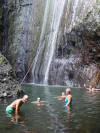 We stayed about three nights in Hanavave
and Jan climbed up to waterfall with a cruiser group one day. On the last night the williwaw
winds from the mountains hit thirty knots, so we decided it was time to
move on. We stayed about three nights in Hanavave
and Jan climbed up to waterfall with a cruiser group one day. On the last night the williwaw
winds from the mountains hit thirty knots, so we decided it was time to
move on.
We sailed up to Tahuata to have a workday - laundry, engine oil change,
etc. -the necessities of life to a cruiser.
Ua Pou
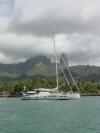 The next morning we left at dawn for Ua Pou. The seas were pretty rolly
and we had 20 knots of wind most of the time, but didn't have any
difficulties. The wind picked up just as we were coming in, so getting the
sails down and into shelter while being chased by a French Navy ship
heading to the same harbor was our bit of excitement for the day. Then Jan
had to translate for a boat from Oregon who was being hailed by the
French. The Aranui was in the tiny port, too, so things were a trifle
chaotic. We were happy to just sit quietly at anchor for the night, even
though it was rolly and very crowded with about 20 boats anchored bow and
stern to save room. It made for some interesting anchoring maneuvers. The next morning we left at dawn for Ua Pou. The seas were pretty rolly
and we had 20 knots of wind most of the time, but didn't have any
difficulties. The wind picked up just as we were coming in, so getting the
sails down and into shelter while being chased by a French Navy ship
heading to the same harbor was our bit of excitement for the day. Then Jan
had to translate for a boat from Oregon who was being hailed by the
French. The Aranui was in the tiny port, too, so things were a trifle
chaotic. We were happy to just sit quietly at anchor for the night, even
though it was rolly and very crowded with about 20 boats anchored bow and
stern to save room. It made for some interesting anchoring maneuvers.
  The next day we did the obligatory check in with the gendarmes, then
wandered around the town to the four minimally supplied stores. The best
part of all was the craft display and kai-kai (picnic) booths that just
happened to be set up that day. The island was preparing to celebrate the
arrival of a big inter-island outrigger canoe race. So of course, we had
to stay and see what that was all about. The next day we did the obligatory check in with the gendarmes, then
wandered around the town to the four minimally supplied stores. The best
part of all was the craft display and kai-kai (picnic) booths that just
happened to be set up that day. The island was preparing to celebrate the
arrival of a big inter-island outrigger canoe race. So of course, we had
to stay and see what that was all about.
The finish of the race was right next to Raven, so we watched all the guys
pulling for all they were worth with whatever strength they had left after
40 miles at sea. It was pretty impressive stuff. Hard to imagine that they
averaged over eight knots under paddle power for five hours in big waves
at sea. They are even allowed to change three of the six paddlers at sea -
one guy jumps out and another pulls himself out of the water and into the
canoe. Whew! When they got to the beach they were greeted by young girls
putting leis around their necks and a matriarchal type giving the official
greeting, a very loud shrieky Polynesian sing-song. There was a lot of
similarity to a canoe arrival we saw in Alert Bay, British Columbia - same
large woman giving the sing-song welcome, same leis around the neck, only
they were cedar leis, not sweet smelling flowers. Sorry, I'm beginning to
sound like a PBS series.
Later that night, again behind our boat, there was a concert on the beach,
which we got to enjoy from our cockpit. Actually, we couldn't avoid it
anyway because the speakers were immense and LOUD. Our favorite piece of
music was "Hotel California" in Marquesan. I had to retrieve our Mexican
earplugs, but we still had a great time.
Nuku Hiva
 The next day we decided to leave for out last Marquesan island, Nuku Hiva,
which is the administrative capital and The Big City. It has quite a bit
of French history and some nice old buildings and a fort dating from the
1840's, but Big City is pushing it. This time there are three stores,
again, not well supplied. The good news is that there are restaurants!!
We've gone out for dinner twice!! What a treat!! (Yes, Jan is way behind
his quota for taking me out to dinner, so he's trying to catch up.)
Tomorrow we're going on another island tour. We hope we can find someone
who sells vegetables and fruits, because we still haven't found any. We're
headed next to the Tuamotus where we already know there are few stores and
no fresh supplies, so we need to pack it all in. The next day we decided to leave for out last Marquesan island, Nuku Hiva,
which is the administrative capital and The Big City. It has quite a bit
of French history and some nice old buildings and a fort dating from the
1840's, but Big City is pushing it. This time there are three stores,
again, not well supplied. The good news is that there are restaurants!!
We've gone out for dinner twice!! What a treat!! (Yes, Jan is way behind
his quota for taking me out to dinner, so he's trying to catch up.)
Tomorrow we're going on another island tour. We hope we can find someone
who sells vegetables and fruits, because we still haven't found any. We're
headed next to the Tuamotus where we already know there are few stores and
no fresh supplies, so we need to pack it all in.
The
Marquesas, Part 2
Whew. A lot has happened
since we last updated this page, so we have plenty to report.
Nuku Hiva Island
Tour
Our guide for the 4x4 tour
of Nuku Hiva was Richard, a young Marquesan who knows all the history of
his island, and can also drive on its abominable roads! It doesn’t seem
possible but the roads here were even worse than those on Hiva Oa, but at
least the scenery was even more spectacular.
 Richard drove us over the
mountainous spine of the island to two other major bays, Taipivai and
Hatiheu, which were major population centers in the centuries before
European diseases wiped out 95% of the population. Everywhere we went we
saw pae pae – ancient stone house platforms – hidden in the
tropical jungle, most of them unused but a few holding up modern houses.
It was almost eerie to see so much evidence of the former glories of these
islands. Richard drove us over the
mountainous spine of the island to two other major bays, Taipivai and
Hatiheu, which were major population centers in the centuries before
European diseases wiped out 95% of the population. Everywhere we went we
saw pae pae – ancient stone house platforms – hidden in the
tropical jungle, most of them unused but a few holding up modern houses.
It was almost eerie to see so much evidence of the former glories of these
islands.
Herman Melville’s Typee
tells of his escape on this island, from a brutal whaling captain while
the ship was anchored in Taioha’e in the early 1800’s. Melville and his
friend Toby climbed on foot over the same ridge we drove over (hey, it was
tough enough in a 4x4!), and were captured or adopted (depending on your
viewpoint) by the tribe of the Taipivai valley. Melville says he was given
a concubine and lived happily there for several months, although since
these were avowed cannibals he could never be quite sure of their good
intentions . . . Both he and Toby eventually escaped and got home to tell
their tale. Now, Taipivai is a beautiful, sparsely-populated, peaceful
farming valley ending in a gorgeous black sand beach on a protected
harbor. No sign of cannibals, just a few guys in the youth group of the
Catholic church making banners for an upcoming pilgrimage to a church on
another island.
 The archeological ruins
Richard showed us at Hatiheu were spectacular: massive constructions of
volcanic stone that must have been the scene of huge ceremonies by the
local tribes. Richard even did part of the famous pig dance for us, just
like the ones that are still done here annually. The largest temple is
built around a banyan tree hundreds of years old, so it must have been
sacred to the tribe at the time. Richard said skulls were imbedded in the
tree when the site was re-discovered and cleared late last century. By a
happy coincidence earlier in the day, we had met Robert Suggs, the
American archeologist who had discovered the site in 1957 and sponsored
its restoration. He was easily identified by the way he chatted happily
away in fluent Marquesan with Richard and the other locals! We asked about
the island’s original population and Suggs said he felt vindicated these
days, as all the scientists have come around to the then-radical viewpoint
he stated in the ‘50’s, that there were at least 100,000 people on
these islands. Now there are only 8,000, up from 2,000 in the 1920’s. The archeological ruins
Richard showed us at Hatiheu were spectacular: massive constructions of
volcanic stone that must have been the scene of huge ceremonies by the
local tribes. Richard even did part of the famous pig dance for us, just
like the ones that are still done here annually. The largest temple is
built around a banyan tree hundreds of years old, so it must have been
sacred to the tribe at the time. Richard said skulls were imbedded in the
tree when the site was re-discovered and cleared late last century. By a
happy coincidence earlier in the day, we had met Robert Suggs, the
American archeologist who had discovered the site in 1957 and sponsored
its restoration. He was easily identified by the way he chatted happily
away in fluent Marquesan with Richard and the other locals! We asked about
the island’s original population and Suggs said he felt vindicated these
days, as all the scientists have come around to the then-radical viewpoint
he stated in the ‘50’s, that there were at least 100,000 people on
these islands. Now there are only 8,000, up from 2,000 in the 1920’s.
 Our lunch stop was at Chez
Yvonne on the north side of the island, for a delicious Marquesan-style
meal of lobster and fish with breadfruit and poisson cru (raw fish
in coconut milk). On the way back over the mountain, Richard told us
stories such as how, soon after the French took control of the islands,
one of the chiefs went to France and received some education, which he put
to good use on his return to Nuku Hiva. It seems he had the other (still
illiterate) chiefs sign papers he said confirmed their land ownership, but
in fact the papers did the opposite. They turned the lands over to the
scoundrel! This is still a current source of much anguish because the
descendents of that chief – named Stanislas, oddly enough – still own
enormous tracts of land, while the other chiefs’ descendants remain
landless. Our lunch stop was at Chez
Yvonne on the north side of the island, for a delicious Marquesan-style
meal of lobster and fish with breadfruit and poisson cru (raw fish
in coconut milk). On the way back over the mountain, Richard told us
stories such as how, soon after the French took control of the islands,
one of the chiefs went to France and received some education, which he put
to good use on his return to Nuku Hiva. It seems he had the other (still
illiterate) chiefs sign papers he said confirmed their land ownership, but
in fact the papers did the opposite. They turned the lands over to the
scoundrel! This is still a current source of much anguish because the
descendents of that chief – named Stanislas, oddly enough – still own
enormous tracts of land, while the other chiefs’ descendants remain
landless.
Anaho Bay
We heard good reports on the
radio nets about a bay on the other side of Nuku Hiva, about 28 miles
away, so we motorsailed upwind to get there one day. Anaho Bay has the
only coral reef of any size in the Marquesas (probably because these
volcanic islands are so geologically young), and is also an excellent
anchorage.
We met Leopold, a Marquesan
living ashore who was busily clearing brush to make pasture for his
horses. He spoke very good English and we asked him if he had learned it
in school. “No, I learned English from reading American surfing
magazines.” We wished we had had some to give him. We traded a T-shirt, a
copied Bob Marley audio CD-R, sunglasses and a few other things for an
enormous quantity of fruit of all kinds, some of which we had never seen
before. He told us that there was never a Marquesan village in his bay,
but that a large colony of slaves lived there to supply Hikokua, the
archeological site we had visited, with the breadfruit essential to
Marquesan life. There was only one small pae pae, so slaves
obviously didn’t merit houses with stone foundations.
Daniel’s Bay
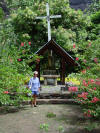 After a quick trip back to
Taioha’e to restock with fresh vegetables (only modestly successful), we
moved to the next bay, nicknamed Daniel’s Bay by the cruisers. That’s
because Daniel and his wife Antoinette have lived there since the 1970s,
welcoming cruisers with fruit and fresh water each season. Daniel has five
large notebooks filled with photos, drawings, and writings from hundreds
of boats. All of us can look through and find plenty of our friends.
They’re both getting on in years, and Antoinette especially has severe
arthritis so we all were contributing the ibuprofen she wanted from our
medical supplies. And everyone drops off tools, rope, clothing, Ziploc
bags, and other useful household items too. They were a very sweet, very
welcoming couple. After a quick trip back to
Taioha’e to restock with fresh vegetables (only modestly successful), we
moved to the next bay, nicknamed Daniel’s Bay by the cruisers. That’s
because Daniel and his wife Antoinette have lived there since the 1970s,
welcoming cruisers with fruit and fresh water each season. Daniel has five
large notebooks filled with photos, drawings, and writings from hundreds
of boats. All of us can look through and find plenty of our friends.
They’re both getting on in years, and Antoinette especially has severe
arthritis so we all were contributing the ibuprofen she wanted from our
medical supplies. And everyone drops off tools, rope, clothing, Ziploc
bags, and other useful household items too. They were a very sweet, very
welcoming couple.
 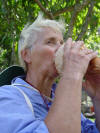 This is also the bay where
the Marquesas episode of the Survivors TV show was filmed a few months
ago. In fact, the TV people bulldozed Daniel’s original home and removed
all trace of it so that the beach could appear pristine for the program.
Not to worry, though. They also built him a new and much nicer home in an
adjacent bay less than a half-mile away, where there are a half-dozen
other homes. Daniel and Antoinette said the TV crowd behaved wonderfully,
spent lots of money, treated all the locals well, and everyone is happy.
(On a side note, one Australian TV technician got into a minor bar scuffle
with our guide Richard. He was flown home the very next morning, in spite
of Richard’s embarrassed protests that they were really friends!) That
beautiful white sand beach is also the home of zillions of the notorious
Marquesan sand flies, called no-nos, whose bites raise big,
intensely itchy welts. The TV crew fumigated the beach every night, lest
the Survivors roughing it on their desert island get their tender skins
bitten! This is also the bay where
the Marquesas episode of the Survivors TV show was filmed a few months
ago. In fact, the TV people bulldozed Daniel’s original home and removed
all trace of it so that the beach could appear pristine for the program.
Not to worry, though. They also built him a new and much nicer home in an
adjacent bay less than a half-mile away, where there are a half-dozen
other homes. Daniel and Antoinette said the TV crowd behaved wonderfully,
spent lots of money, treated all the locals well, and everyone is happy.
(On a side note, one Australian TV technician got into a minor bar scuffle
with our guide Richard. He was flown home the very next morning, in spite
of Richard’s embarrassed protests that they were really friends!) That
beautiful white sand beach is also the home of zillions of the notorious
Marquesan sand flies, called no-nos, whose bites raise big,
intensely itchy welts. The TV crew fumigated the beach every night, lest
the Survivors roughing it on their desert island get their tender skins
bitten!
 Hakaui Valley, where Daniel
and Antoinette now live, was formerly the site of another large population
center. We walked a few miles inland following the river up the valley on
an ancient royal road, made of huge volcanic stones raised a foot or two
above the valley floor. We passed pae pae after pae pae
hidden in the trees and brush, which again gave us that eerie feeling of
lives cut short by warfare and disease. But the site is still beautiful,
the river water cool on the skin after a sweaty hike, and the people
delightful as always. Hakaui Valley, where Daniel
and Antoinette now live, was formerly the site of another large population
center. We walked a few miles inland following the river up the valley on
an ancient royal road, made of huge volcanic stones raised a foot or two
above the valley floor. We passed pae pae after pae pae
hidden in the trees and brush, which again gave us that eerie feeling of
lives cut short by warfare and disease. But the site is still beautiful,
the river water cool on the skin after a sweaty hike, and the people
delightful as always.
And so . . . on to the
Tuamotus . . .
Previous
log
Next log
This page was last
updated on
04/13/04. |